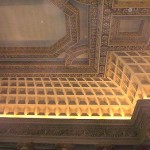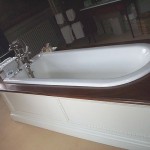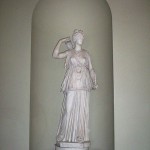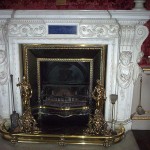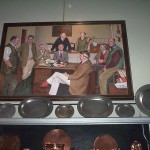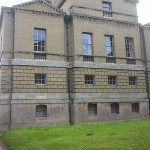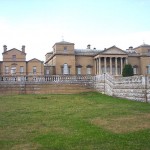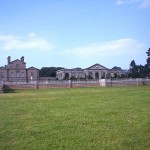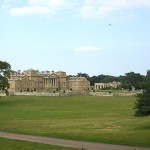If you need a cheap or classic car to visit the places described in this blog, a friend’s family is selling a Volvo 360:
Volvo300Mania Location = Watford, UK, colour = green, mileage = 73,000, condition = good. Pictures available if you contact the seller.
Lydford Castle, Devon
English Heritage
Lydford Castle is a small keep of Norman origin, rising above a mound in the middle of the village. In fact, the castle is not built on the mound – the mound was constructed around the lowest level of the structure when it was modified in the 13th century. It was used as a notorious prison for several centuries. It is now ruined and roofless.
The castle is worth a look if you are in the Lydford area. Apparently there are other Norman and Saxon defensive works to be seen nearby, so the downloadable audio tour to Lydford Castle and Saxon Town seems worth having.
Open at any reasonable time.
Lydford Gorge, Devon
National Trust
There are about three miles of trail on both sides of the gorge at high and low levels. The gorge is green with trees and other growth. Water rushes over the rocky river bed, and there is a famous vertical waterfall, the White Lady, and a whirlpool, the Devil’s Cauldron.
This is a popular beauty spot and well worth a visit. Note that the going is quite difficult, with wet, uneven and potentially slippery surfaces, and the paths have steep gradients. Walkers should wear suitable boots and have adequate physical fitness.
Admission charge.
Rhythm Festival 2011
Rhythm Festival 2011 – Logistics Report.
I bought a day ticket in advance for the Sunday of this 3-day festival. The ticket arrived in good time by post. On arriving at Old Warden on the Sunday morning I found there was no festival traffic, so had to cruise through the village looking for the festival entrance. There wasn’t any trail of temporary signs. There was adequate parking on a field close to the arena entrance.
The festival boasted five stages: the primary outdoor stage, a second outdoor stage, an indoor stage in a marquee, and two more inside buildings. The land in the arena is unusually hilly, which provided complete visual and sound separation between the primary, second and marquee stages. If you want to sit, bring a folding chair. There was a huge beer tent (a handy place to retreat to during a rain shower), and the provision of toilets and catering was also adequate. Interestingly, on the ridge at the back of the primary stage spectator area was a line of tented booths for privileged spectators (corporates or paid extra). In case you needed something else to do there was a cinema marquee and a funfair on site as well.
As for the music, I’m no music reviewer but I enjoyed the music which, headlined by Toots and the Maytals, was clearly aimed at older rock fans. Attendance was of the order of 5000.
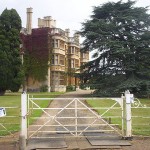
Warwick Folk Festival 2008
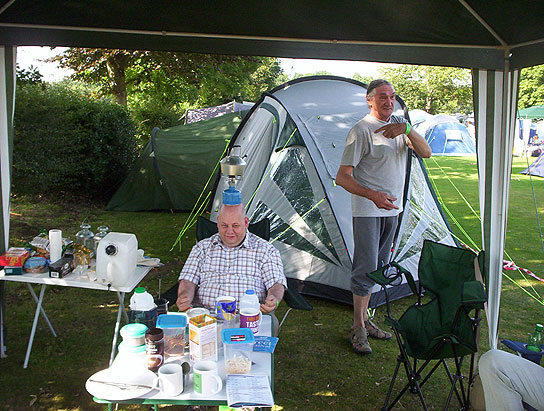
The festival is held yearly in the grounds of Warwick School – a private fee-paying school. The school has lots of green space and other facilities – halls, a small theatre, and even a swimming pool, all available to the festival. Camping and parking is on the same site, about a mile from the centre of the town.
The festival is quite popular and the camping areas correspondingly large, so if you have arranged to meet friends onsite and camp beside them, finding them could be something of a trial. All organised music performances are under cover with seating, the main stage being in a marquee. There are some off-site events (sessions, dance performances) in the town itself. Catering and toilet facilities were adequate, and there was floodlighting at night.
As for the music, Warwick attracts some leading folk acts each year, and there is a full programme of support acts and workshops, not to mention the informal camp-site sessions.
If you want something else, Warwick Castle offers special festival deals.
Rhythms of the World Festival 2010, Herts
Rhythms of the World Festival 2010 – Logistics report.
The festival was held at the Priory Park in Hitchin, a green space near the centre of the town. Note that this is a day festival (2 days) and you can buy a ticket for either day, or both. There is no camping.
Parking is an issue here, and the organisers encourage attendees to come by public transport. Hitchin railway station is a mile from the site. There is no on-site parking, and even drop-off outside could be a problem, because of the narrow streets. The official parking was at Butt’s Close, another large green space in the town some 10 mins walk away. For your future reference, the vehicle entrance to Butt’s Close is from Fishponds Road. You will exit on foot from the far end of the parking area. Of course, there are also pay car parks around the town centre.
Before you get in, there is a bag check for excess alcohol, etc.
Once inside, there are at least five stages to choose from. The “World Music” acts all appeared on the main stage, and were generally of a high standard. I saw a Touraeg band from North Africa – wish I could have got a CD of them. Supporting acts on the other stages were a variety of rock, pop, folk, or unclassifiable, and mainly of local, i.e. home counties, origin. Only one of the stages (the church-sponsored one) had seating or cover for spectators.
Considering the quality World Music and the ticket price of under £10 per day, superb value for money. Toilet and catering facilities were adequate.
Cropredy Festival 2011
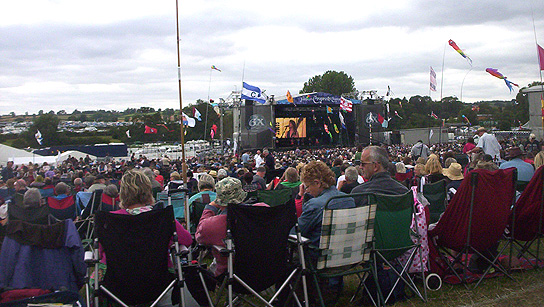
I decided to go to this festival at the last moment. Unusually, it takes place over a Thursday/Friday/Saturday, with the main acts being concentrated on the Saturday. I reached the village without any trouble despite the closure of the A361. In fact, having started a bit late on the Saturday morning, I drove through the village and into no.7 day car park without being held up at all, a complete contrast to the mile-long queues and axle-deep mud I had braced myself to expect.
Next I had a lengthy walk through the outer areas to find the ticket booth and hand over £70 for a Saturday ticket, and an equally lengthy walk back to find the arena entrance. Inside, I soon realised what important thing I’d forgotten to bring – a folding chair! The attendance was of the order of 20,000, and it looked like at least 90% of them were seated on folding chairs, in massed rows. I’d never seen anything like it. Unfortunately, without a chair one had to stand for hours or sit on the ground and suffer a view restricted by the seated, or people walking by every few seconds, or worse still stopping in front of one to jaw to some friend they hadn’t seen since last year.
Toilet and catering facilities were adequate. The beer came in by tanker lorry (no joke). As you can see from the photo, many attendees were as old as the Fairports. I’m no music critic, but the final Fairport & friends set and the support acts were really good.
At the end, it took a while to get out of the arena and reach no.7 car park in the dark, but once in the car I was able to get on my way without much trouble.
Dartmoor Prison Museum, Devon
The Museum is about 150 yards from Dartmoor Prison, and housed in a building that used to be the prison dairy. It is the only museum run by HM Prison Service to be open to the public. The Museum narrates the history of the prison, and also includes the “Black Museum” of weapons and other items confiscated from prisoners, a collection of manacles and weapons, details of famous prisoners, insignia and uniforms, and the Prison today.
I recall that this was quite an interesting visit.
There is a small admission charge. Free car parking. Note that the Museum closes for lunch.
Cowper and Newton Museum, Bucks
The Museum is situated in a large 17th century house facing the marketplace in Olney. It was the home from 1768-1786 of the poet William Cowper and his companion Mary Unwin. The Rev John Newton, slave trader turned abolitionist and hymn writer, lived nearby at the Vicarage. The building contains two separate houses, known as Gilpin House and Orchard Side, and there are a Georgian walled flower garden and a Victorian kitchen garden at the rear. Today, the building contains museum displays devoted to both men and to local history.
The museum makes an interesting visit,as the displays inform one about both men and about the slave trade, and local history including the local lace-making industry. The 17th century house itself, with its slightly uneven floors and its mezzanine rooms at the back, is an interesting object. The gardens are also worth investigating, and when I visited there was some sort of historical re-enactment going on in the rear one.
Admission charge.
Holkham Hall, North Norfolk
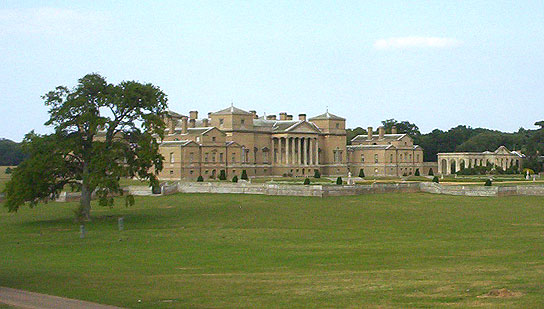
The house opening hours are quite restricted, and it can take 2 hours to go around the interior, so it’s as well not to be distracted by any outside exhibits, walks, tea-rooms etc. On entering, the visitor’s reaction is likely to be Gosh!! Look at that!! rather than “nice room”. This is said to be the most impressive hall in England, with alabaster walls, Roman columns, a double staircase, coffered cieling, semicircular vaults, bas-reliefs, side balconies, plasterwork, and lots and lots of gold-leaf. Several of the other rooms carry on the same theme, such as the sculpture gallery (with ancient Roman sculpture), the libraries (with Birds of America and scores of huge volumes of the Cosmographica, a medaeval world atlas, on the shelves), and the Drawing Room, Saloon and South Dining room all built and furnished to impress.
If you stand in the right spot in the saloon you can see an enfilade right from one end of the house to the other, and at 90 degrees to that, a monument out in the parkland to the north, and another to the south, both on the axis you’re standing on. Paintings are well represented, and some are by famous artists, and some are big (or both). The tour ends in the Old Kitchen, in one of the wings – a room big enough to swallow the whole of my house, and probably some of yours as well.
Unusually, the hall has never suffered major alterations, or sales of contents, and still belongs to the Cokes, descendants of the builder.
Outside, there’s the the park and the estate, which stretches to the sea, a walled garden (which I didn’t see), and outbuildings, and some private gardens. Around the service courtyard are the ticket office, tea-rooms and some exhibitions. The Bygones exhibition (a chargeable extra) containing various artefacts and vehicles, is interesting, but could be skipped if you’ve seen that sort of thing elsewhere or are short of time. The history of farming exhibition (free) is quite interesting. It’s worth asking what discounts are available, as with parking (£2.50), guidebook (£6) etc a visit can become quite expensive.
I arrived arround mid-day, but Holkham is a suitable destination for an all-day visit.
